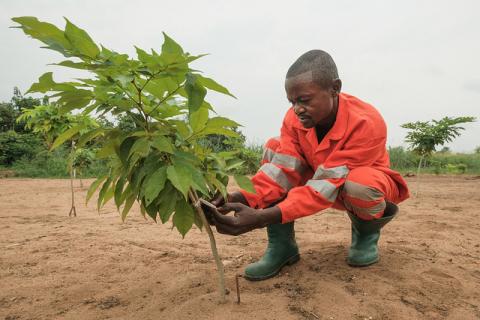
Progress towards sustainable forest management
Last updated on 1 February 2022
This indicator is currently classified as Tier I. The Food and Agriculture Organization of the United Nations (FAO) is the Custodian agency for this indicator.
Unit of measure: Annual forest area change rate (%); above-ground biomass stock in forest (t per hectare); proportion of forest area located within legally established protect areas (%); proportion of forest area under a long-term forest management plan (%); forest area under an independently verified forest management certification scheme (1000 hectares)
Why is this indicator important?
Together with indicator 15.1.1, this indicator aims to strengthen forest governance at all levels as well as balancing conservation and the sustainable use of natural resources. Forests are the largest biodiversity and carbon reservoirs. Moreover, they provide livelihoods and proved to be a safety net during the COVID-19 pandemic. At the same time, the pandemic may contribute to increasing deforestation as people may turn to forest products for subsistence.
Sustainable forest management is defined by the UN General Assembly (Resolution A/RES/62/98), as follows:
[a] dynamic and evolving concept [that] aims to maintain and enhance the economic, social and environmental values of all types of forests, for the benefit of present and future generations.
Sustainable Forest Management is a dynamic and multidimensional concept which considers environmental, economic, and social aspects. Understanding changes in forest resources may help identify unsustainable practices in the forestry and agricultural sector and thus inform policy and management actions, as well as guide public and private investment. Adequate forest resources ensure social, economic and environmental stability as well as sustainable development for future generations.
How is the indicator measured and monitored?
Indicator 15.2.1 is composed of five sub-indicators that measure progress towards all dimensions of sustainable forest management. The environmental values of forests are covered by three sub-indicators focused on annual forest area change, aboveground biomass in forest and the proportion of forest area within protected areas. Social and economic values of forests are reconciled with environmental values through one sub-indicator covering the proportion of forest area under long-term management plans and another sub-indicator assessing forest area under an independently verified forest management certification scheme. However, particularly social and economic aspects are not fully addressed.
According to the metadata document, most data is provided by the Global Forest Resources Assessment (FRA) that is carried out every five years. FRA 2020 is the latest assessment covering 236 countries. In addition, sub-indicator 5 draws on data submitted annually by the Forest Stewardship Council (FSC) and the Programme for the Endorsement of Forest Certification (PEFC). A dashboard is used to assess progress related to the five sub-indicators. Only the countries with complete data (by year) are included in regional and global aggregates.
By Anne Hennings, peer-reviewed by Anne Branthomme, Forestry Officer at FAO.
Official indicator data
The indicator is composed of five sub-indicators that measure progress towards all dimensions of sustainable forest management: Annual forest area change rate; above-ground biomass stock in forest; proportion of forest area located within legally established protect areas; proportion of forest area under a long-term forest management plan; forest area under an independently verified forest management certification scheme.
* Select "year" below to see the most recent data for more countries.
** To refresh the map with other official data, use the ’Select an indicator field’. Type in the other indicators titles, as given in the table below.
Other related indicators on Land Portal
In addition to the official indicator data, the following indicators provide information related to the Bonn Challenge Commitment.
Land, forests and climate: achieving sustainable and inclusive economic development in Africa’s forest landscapes
Date: 9th October 2018
Time: 12:30-16:00 BST
Location: Overseas Development Institute, London
Paginación
- Previous page ‹ previous
- Page 2
![]()

By 2020, promote the implementation of sustainable management of all types of forests, halt deforestation, restore degraded forests and substantially increase afforestation and reforestation globally
Indicator details
The Indicator is conceptually clear, has an internationally established and available methodology and standards, and that data is regularly produced by countries for at least 50 per cent of countries and of the population in every region where the indicator is relevant.
Key dates:


